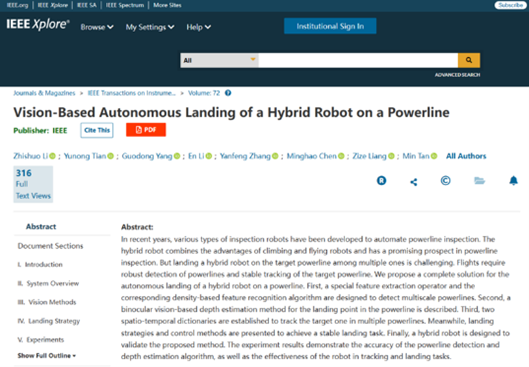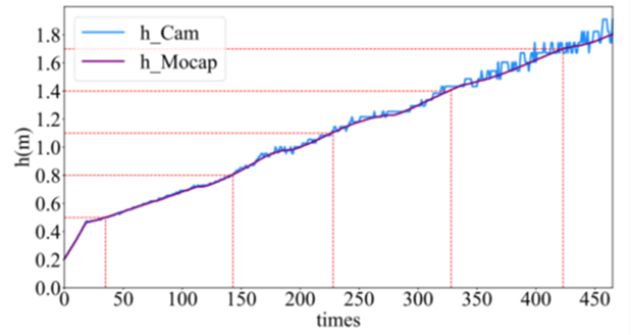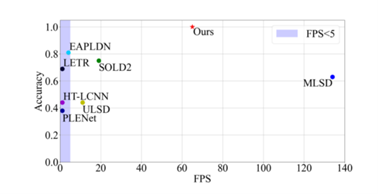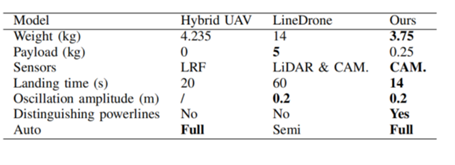Recently, a research team from the Institute of Automation of the Chinese Academy of Sciences published a paper entitled "Vision-Based Autonomous Landing of a Hybrid Robot on a Powerline" in the SCI-indexed journal IEEE Transactions On Instrumentation and Measurement.

IEEE Xplore
The authors proposed a comprehensive solution for the autonomous landing of a hybrid robot on a powerline. They designed a method for detecting multi-scale powerlines, described an approach for estimating the depth of the landing point, and established a spatiotemporal dictionary for tracking target powerlines. Additionally, they introduced landing strategies and control methods to achieve stable autonomous landing. In the end, the effectiveness of the powerline detection and depth estimation algorithms was validated through experiments with the hybrid robot.
1. Research background
In recent years, various types of inspection robots have been used for automated power line inspections. Hybrid robots, combining the advantages of crawling and flying robots, show great potential in the field of power line detection. However, landing a hybrid robot on a target power line poses a challenge, requiring robust detection and tracking of power lines. The development of a multi-scale transmission line detection method has become an urgent necessity.
2. Experimental Process
The authors used the robot platform designed in this paper to conduct the following evaluations: First, they assessed depth accuracy under the motion capture system; then, they validated the reliability and effectiveness of the proposed tracking algorithms and landing strategies; finally, they provided two comparative experiments to demonstrate the superiority of the methods presented in this paper.
The authors used the robot platform designed in this paper for the following evaluations: First, they assessed depth accuracy under the NOKOV motion capture system; then, they verified the reliability and effectiveness of the proposed tracking algorithms and landing strategies; finally, they provided two comparative experiments to demonstrate the superiority of the methods presented in this paper.
1.1 Depth estimation accuracy test

Relative height between the power line and the camera measured by the algorithm and the motion capture system

Error of the algorithm at different depths
1.2 Tracking test
The experiments showed that despite irregular changes in the number of lines, the target line was still tracked effectively. When the lateral velocity in automatic mode remained below the maximum speed during the tracking experiments, the tracking method proposed in this paper met the requirements of practical landing tasks.
1.3 Line Dropping Test
The research team validated the proposed power line extraction algorithm and landing strategy on the robot. Despite the continuous scale variations of the transmission lines, the target line was still detected and tracked effectively, while inclined lines were mostly filtered out in the binary images. The experiments demonstrated that the autonomous line dropping solution proposed in this paper is effective.
1.4 Comparative Experiments
1) Performance Comparison:
Figure 2 displays the quantitative results. It can be observed that the algorithm proposed in this paper outperforms other methods in terms of accuracy.

Comparison of accuracy and processing speed of multiple detection methods
2) Inspection Performance Comparison:
From Table 2, when landing from a height of 1 meter above the transmission line and at 0.2 meters from the side of the transmission line, the hybrid robot designed in this paper achieved a shorter average landing time. Additionally, the robot designed in this paper can differentiate between transmission lines with similar features and track the target transmission line, making it more stable and practical in real-world transmission networks.

Comparison of inspection performance across multiple robot platforms
3. Experiment Conclusions
This paper presents a comprehensive autonomous line dropping solution that enables a hybrid robot to land on powerlines. Compared to traditional powerline detection algorithms, the method employed in this paper can detect powerlines of multiple scales and calculate the landing point relative to the robot's position. The accuracy of depth estimation is assessed through a motion capture system, meeting the requirements of landing tasks. Furthermore, the authors propose establishing two dictionaries to track the target powerlines. In a series of outdoor experiments, the effectiveness of the tracking method and landing strategy is demonstrated. The research in this paper shows that the robot can distinguish powerlines with similar features and successfully land on the target powerline. In the future, the authors plan to explore ways to reduce landing time and enhance the system's robustness in high-wind environments.
Bibliography: